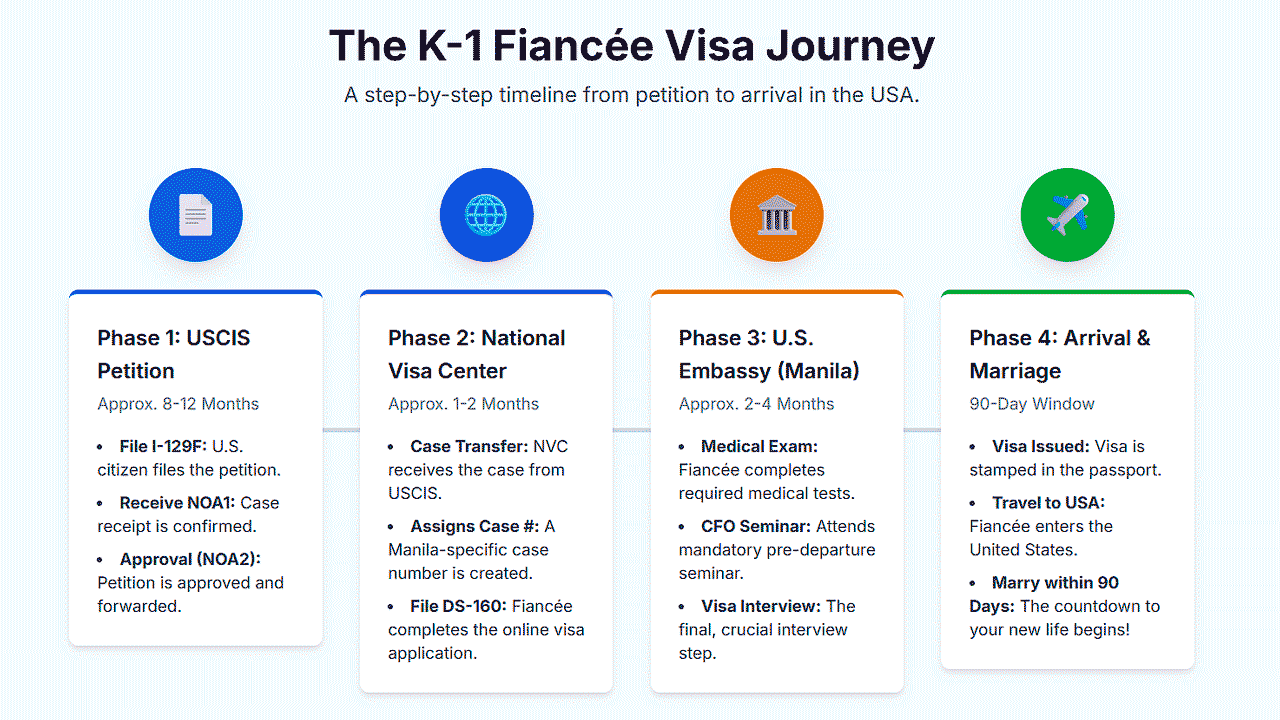K-1 Fiancée Visa Philippines: A Complete Guide for 2025

You’ve found the love of your life in the Philippines. Now, the dream is to bring her home to the United States to start your life together. The path to achieving that dream is the K-1 Fiancée Visa. While the process can seem daunting, filled with acronyms, forms, and waiting periods, it is a well-trodden and manageable journey.
Think of this guide as your personal roadmap. We will break down each stage of the K-1 visa process into clear, actionable steps, from filing the first petition to the moment your fiancée arrives in the US. Our goal is to replace confusion with confidence and help you navigate this crucial step successfully.

What is a K-1 Fiancée Visa?
The K-1 visa is a nonimmigrant visa that allows the foreign-citizen fiancée of a U.S. citizen to travel to the United States and marry their sponsor within 90 days of arrival. Once you are married, your new wife can then apply for an Adjustment of Status to become a Lawful Permanent Resident (receive her Green Card) without having to leave the country.
Who is Eligible for a K-1 Visa?
To successfully petition for a K-1 visa, both you (the U.S. Citizen Petitioner) and your fiancée (the Filipina Beneficiary) must meet specific requirements.
For the U.S. Citizen Petitioner:
- You must be a U.S. citizen.
- You and your fiancée must have met in person at least once within the two years prior to filing the petition. (There are very limited exceptions to this rule).
- You must both be legally free to marry (single, divorced, or widowed).
- You must intend to marry each other within 90 days of her entry into the U.S.
- You must meet the minimum income requirements to financially support your fiancée, as outlined in the Affidavit of Support (Form I-864).
For the Filipina Fiancée (Beneficiary):
- She must be a citizen of the Philippines.
- She must be legally free to marry.
- She must not have certain criminal convictions or immigration violations that would make her inadmissible to the U.S.
- She must pass a medical examination.
The K-1 Visa Process: A Step-by-Step Guide
Here is a simplified overview of the major milestones in your K-1 visa journey. For a visual representation, see the timeline below.
Step 1: File Form I-129F, Petition for Alien Fiancé(e)
This is the starting point. You, the U.S. citizen, will compile a petition package that includes the completed Form I-129F, supporting documents proving your identity and citizenship, and extensive evidence of your bona fide relationship. This evidence includes photos together, communication logs (emails, chat history), flight itineraries from your visits, and letters of intent to marry from both of you.
Step 2: USCIS Processing (NOA1 and NOA2)
After filing, you will receive a Notice of Action 1 (NOA1), confirming receipt of your case. Then, you wait for USCIS to process the petition. Upon approval, you will receive a Notice of Action 2 (NOA2). This approval means USCIS is satisfied with your relationship evidence and has forwarded your case to the next stage.
Warning: Request for Evidence (RFE): If your initial evidence is weak, USCIS may issue an RFE, requesting more proof of your relationship. This can cause significant delays. It is crucial to submit a strong, well-documented petition from the start.
Step 3: National Visa Center (NVC) Stage
After USCIS approval, the case moves to the Department of State’s National Visa Center. The NVC assigns a case number and forwards your petition to the U.S. Embassy in Manila, Philippines.
Step 4: The Embassy Interview in Manila
This is the most critical stage for your fiancée. The U.S. Embassy in Manila will send her instructions for the final steps: completing Form DS-160 (Online Nonimmigrant Visa Application), paying the visa fee, scheduling a medical exam at St. Luke’s Medical Center Extension Clinic, and gathering her civil documents. She will then attend a visa interview where a consular officer will ask questions about your relationship to verify its legitimacy one last time.
Step 5: Visa Approval and Entry to the U.S.
If the interview is successful, her passport will be returned with the K-1 visa stamp. From the date of issuance, she typically has six months to enter the United States. The 90-day clock to get married starts ticking the moment she arrives on U.S. soil.

K-1 Visa Timeline & Costs
Timelines and costs are subject to change based on government processing speeds and fee updates. The following is a general estimate as of 2025.
| Process Stage | Estimated Timeline | Estimated Cost (USD) |
|---|---|---|
| Form I-129F Petition Fee | – | $535+ |
| USCIS Processing Time | 8 – 14 months | – |
| NVC to Embassy Transfer | 1 – 2 months | – |
| DS-160 Visa Application Fee | – | $265 |
| Medical Examination in Manila | – | ~$335 |
| Total Estimated Timeline | 12 – 18+ months | – |
| Total Estimated Base Cost | – | ~$1,200+ |
Note: This does not include costs for travel, document gathering, or potential lawyer fees. For a complete financial picture, see our guide to the true cost of finding a Filipina wife.
Frequently Asked Questions (FAQ)
What happens after we get married in the U.S.?
Within 90 days of marriage, your wife must file Form I-485, Application to Register Permanent Residence or Adjust Status. This is the application for her Green Card. She will also apply for work authorization (Form I-765) and travel permission (Form I-131).
Can my Filipina fiancée bring her children to the U.S.?
Yes. Her unmarried children under the age of 21 can apply for a K-2 visa to accompany her. You must include the children on the initial I-129F petition.
What are the most common reasons for a K-1 visa denial?
The most common reasons are: 1) The consular officer is not convinced the relationship is bona fide (real). 2) The U.S. petitioner does not meet the income requirements. 3) The Filipina beneficiary has a past criminal record or immigration violation.
A Journey Worth Taking
The K-1 visa process is a marathon, not a sprint. It requires patience, organization, and unwavering commitment. While this guide covers the process, remember it’s just one part of your larger adventure together. For a complete overview of every stage, from dating and cultural understanding to marriage and expat life, our Mabuhay Welcome Kit is your essential companion.



